Buying a Road Bike
All the Factors That You Should Consider When Buying a Road Bike
Considerations When Buying a Road Bike
Welcome to our handy guide on ‘Considerations When Buying a Road Bike’.
Here, we’ll navigate you through the myriad of options in the world of road bikes and help you identify what truly matters when making a purchase.
From pinpointing your cycling purpose to deciphering frame materials, understanding bike fit, assessing components, evaluating wheels, budgeting, and weighing brand reputations – our guide aims to equip you with the essential knowledge for a smart investment in your cycling future.
So, let’s start your journey towards finding that perfect road bike!
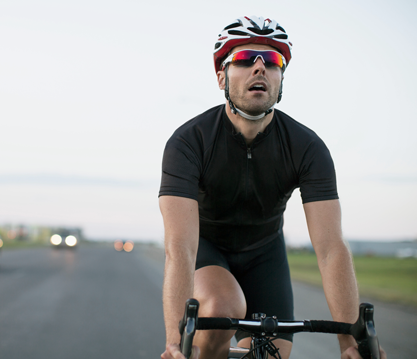 What Purpose Does Your Road Bike Need To Serve?
What Purpose Does Your Road Bike Need To Serve?
First and foremost, consider what you’ll be using the bike for.
Are you planning to engage in competitive racing, or are you looking for a bike suitable for long, leisurely rides?
Perhaps you need a reliable, comfortable bike for daily commuting, or maybe you’re interested in tackling mixed-terrain adventures on a gravel bike.
Determining your purpose will significantly influence the type of road bike you should select, as each category is tailored for specific riding conditions and uses.
For example, a race bike prioritizes speed and performance, while an endurance road bike focuses on rider comfort over longer distances.
Similarly, a gravel road bike is built robustly to handle off-road trails, and a commuter bike often incorporates features for convenience and practicality.
By identifying your cycling needs and aspirations, you can effectively narrow down the suitable types of road bikes to consider.
For a comprehensive look at the different styles of road bikes read our detailed descriptions here.
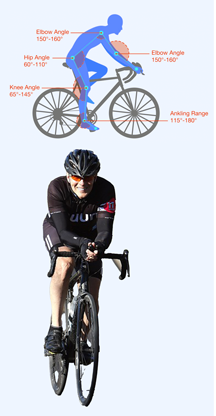 How Does The Bike Fit?
How Does The Bike Fit?
Bike fit is crucial when buying a road bike, as it can significantly affect your comfort, efficiency, and overall riding experience.
Here’s what you need to consider:
Size:
The size of the bike is usually given as the length of the seat tube.
Bike manufacturers may use different sizing conventions (e.g., small, medium, large, or actual measurements), so it’s best to check the specific size chart for the brand.
Geometry:
The geometry of the bike determines your riding position.
Race-oriented bikes typically have a more aggressive, aerodynamic position, while endurance bikes offer a more upright, comfortable position.
Adjustments:
The saddle height, saddle fore-and-aft position, handlebar height, and reach to the handlebars can all be adjusted for a better fit.
You might need to change components, like the stem or seatpost, to achieve the perfect fit.
Professional Bike Fit:
A professional bike fit is an excellent investment.
It ensures your bike is tailored to your body, reducing the risk of discomfort or injury and increasing riding efficiency.
Never underestimate the importance of a proper bike fit. Riding a bike that fits you well will provide a more enjoyable and efficient cycling experience.
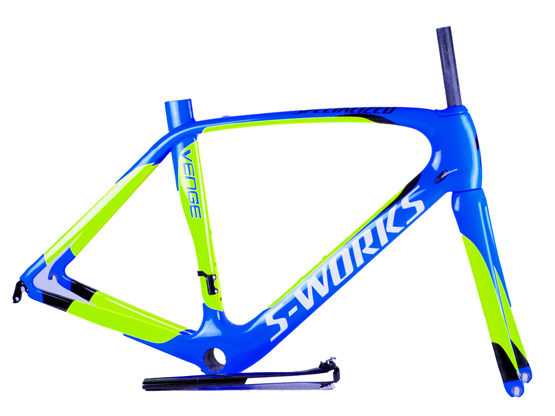 When Buying A Road Bike Which Type of Frame Material Should You Choose?
When Buying A Road Bike Which Type of Frame Material Should You Choose?
The frame material of a road bike can significantly impact its weight, ride quality, durability, and price.
Here’s a rundown on the most common types:
Aluminum:
Aluminum is a popular choice due to its blend of low weight, strength, and affordability.
It offers a stiff and responsive ride, making it great for fast-paced cycling and racing.
Carbon Fiber:
This material is favored for high-end road bikes because of its strength, lightness, and ability to be molded into aerodynamic shapes.
It’s also excellent at dampening road vibrations, providing a smooth ride, but it tends to be pricier.
Steel:
Known for its durability and comfort, steel frames offer a smooth ride due to their natural vibration absorption.
They tend to be heavier than aluminum and carbon fiber, but they’re also typically less expensive.
Titanium:
Titanium combines the best properties of the other materials.
It’s as light as aluminum, as strong as steel, and absorbs vibration like carbon fiber.
However, titanium frames are the most expensive due to the complexity of working with the material.
Selecting the right frame material comes down to balancing your budget with your performance requirements and the ride feel you prefer.
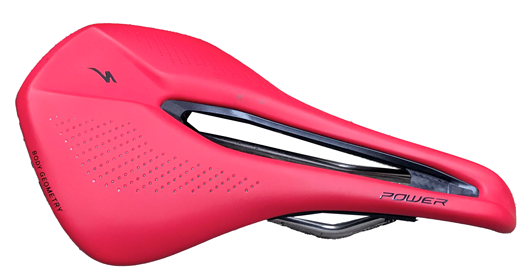 The Saddle/ Seat?
The Saddle/ Seat?
When considering buying a road bike, the saddle or seat is an important component to pay attention to as it directly affects your comfort and enjoyment while riding.
Here are some factors to consider when evaluating the saddle:
Comfort
The primary consideration for a saddle is comfort.
Look for a saddle that suits your body shape, riding style, and preferences.
It should provide adequate support for your sit bones and have enough padding to cushion the pressure points without being too soft.
Width and Shape
Saddle width is crucial to ensure proper support for your sit bones.
Saddle widths vary, and it’s essential to measure your sit bone width or seek professional assistance to determine the appropriate size.
The shape of the saddle also matters; some are flat, while others have a curve or a cutout in the center to relieve pressure on sensitive areas.
Riding Position
Consider your riding style and position on the bike.
If you have an aggressive, forward-leaning position, a narrower and more performance-oriented saddle may be suitable.
For an upright or more relaxed riding position, a wider and more cushioned saddle might be preferred.
Materials and Padding
Saddle construction materials and padding affect comfort, durability, and weight.
Many road bike saddles feature synthetic materials like nylon or carbon-reinforced shells for durability and lightweight.
Padding can vary from thin and firm to thicker and more cushioned.
Finding the right balance is important, as excessive padding can lead to discomfort or numbness over longer rides.
Cutouts or Channels
Some road bike saddles have cutouts or channels in the center to relieve pressure on soft tissues and improve blood flow.
These designs can be beneficial, particularly for riders who experience discomfort or numbness in the perineal area.
Personal Preference and Testing
Saddle choice can be highly subjective, and what works for one person may not work for another.
It’s essential to test ride different saddles to find the one that feels comfortable for you.
Many bike shops offer saddle demo programs or have fitting specialists who can help you find the right saddle based on your anatomy and riding style.
*Remember that saddle comfort is influenced by factors beyond the saddle itself, such as bike fit, riding position, and riding apparel.
Investing time in finding the right saddle can greatly enhance your comfort and enjoyment on the road.
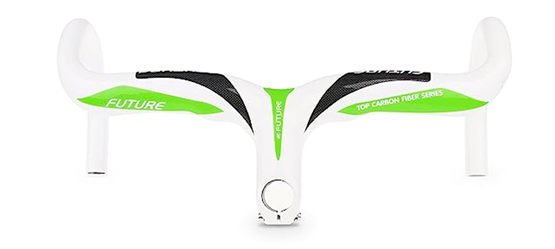 The Handlebars and Stem?
The Handlebars and Stem?
When considering buying a road bike, the handlebars and stem are essential components that greatly impact your riding comfort, control, and overall experience.
Here are some factors to consider:
Handlebars
Handlebar Type
Road bikes typically come with drop handlebars, which offer multiple hand positions for various riding conditions.
There are different types of drop bars, including traditional drop bars, compact bars, and aero bars.
Each type has its own shape and reach, affecting your riding posture and comfort.
Test different handlebar types to find the one that feels the most comfortable and suits your riding style.
Handlebar Width
The width of the handlebars should match your shoulder width for optimal control and comfort.
The correct handlebar width provides better stability and maneuverability.
It’s recommended to get a professional bike fitting or seek guidance from a knowledgeable bike shop to determine the appropriate handlebar width for your body.
Handlebar Shape
Handlebars come in various shapes, such as round, ergonomic, or flattened on the tops.
Ergonomic or flattened tops can offer a more comfortable resting position for your hands during long rides.
Consider your hand preferences and comfort when selecting the handlebar shape.
Stem
Stem Length and Angle
The stem connects the handlebars to the fork steerer tube and affects your riding position.
The stem length and angle determine your reach and overall riding posture.
Longer stems provide a more stretched-out and aerodynamic position, while shorter stems offer a more upright and relaxed position.
Bike fit and personal preference play a crucial role in determining the appropriate stem length and angle.
Handlebar Tape
Handlebar tape provides grip, cushioning, and vibration dampening.
Consider the material, thickness, and texture of the handlebar tape for your comfort preferences.
Thicker tapes may provide more cushioning but can feel bulky, while thinner tapes can offer a better feel of the road but may transmit more vibrations.
Adjustability
Some stems and handlebars offer adjustability in terms of angle and height.
This adjustability allows for fine-tuning your riding position for optimal comfort and performance.
If possible, choose a road bike with adjustable components to accommodate your preferences and potential future fit adjustments.
It’s important to note that handlebar and stem selection should consider factors such as bike fit, riding style, and personal preferences.
Professional bike fitting or consulting with experts at a bike shop can provide valuable guidance in choosing the right handlebars and stem for your specific needs.
Additionally, test riding different bikes and handlebar setups can help you determine the most comfortable and suitable option for you.
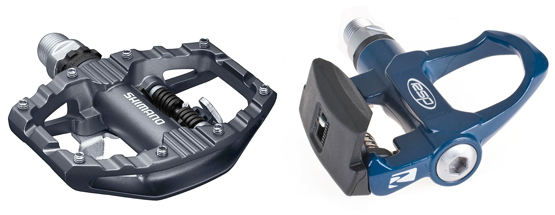 Pedals
Pedals
When considering buying a road bike, the choice of pedals is an important consideration as they directly affect your connection to the bike and power transfer.
Here are some factors to consider when evaluating pedals:
Pedal Type
Road bikes typically use two main types of pedals: flat pedals (also known as platform pedals) or clipless pedals.
Each type offers different benefits and considerations:
Flat Pedals
Flat pedals have a large platform and allow you to ride with any type of footwear, such as regular shoes or sneakers.
They are beginner-friendly, easy to use, and provide a sense of security since your feet can easily be placed on and off the pedals.
Flat pedals are popular for casual riding, commuting, or riders who prefer the freedom of foot movement.
Clipless Pedals
Despite the name, clipless pedals require special cycling shoes with compatible cleats that clip into the pedals.
They offer a secure and efficient connection between your feet and the bike, allowing for better power transfer and more efficient pedaling.
Clipless pedals provide a consistent foot position, help prevent foot slippage, and can enhance pedaling efficiency, particularly during long rides or races.
They are favored by many road cyclists, including enthusiasts and competitive riders.
Cleat Compatibility
If you opt for clipless pedals, ensure that the pedals and cycling shoes are compatible with the same cleat system.
The most common cleat systems for road cycling include Shimano SPD-SL, Look Keo, and Speedplay.
Entry and Release Mechanism
Clipless pedals have different entry and release mechanisms, which affect how easy it is to engage and disengage your feet.
Some pedal systems have adjustable tension, allowing you to customize the release force to your preference.
Consider the ease of entry and release when choosing clipless pedals, particularly if you are new to them or have concerns about quick foot disengagement.
Personal Preference
Pedal choice is often a matter of personal preference and riding style.
Some riders may prefer the simplicity and versatility of flat pedals, while others prioritize the efficiency and connection of clipless pedals.
It can be helpful to test ride different pedal types to see which feels most comfortable and natural to you.
Skill Level and Experience
Consider your skill level and experience as a rider.
Flat pedals are generally more beginner-friendly and can be a good choice for those new to road cycling or looking for a more casual riding experience.
Clipless pedals require a bit of a learning curve and can take time to get used to, especially in terms of clipping in and out smoothly.
*It’s important to note that regardless of the pedal type you choose, proper technique and practice are essential.
Clipless pedals require learning how to clip in and out safely, while flat pedals benefit from using proper foot placement and maintaining good pedaling form.
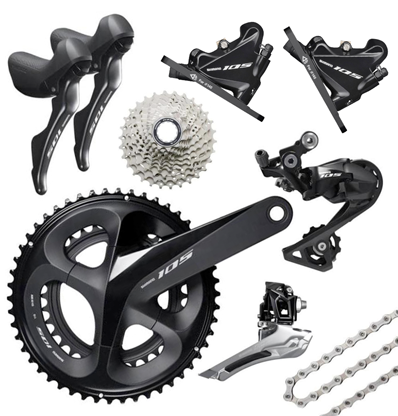 The Groupset?
The Groupset?
When considering buying a road bike, the groupset is a crucial component that greatly impacts your bike’s shifting performance, gear range, and overall functionality.
Here are some factors to consider when evaluating the groupset:
Brand and Level
Well-known manufacturers of road bike groupsets include Shimano, SRAM, and Campagnolo.
Each brand offers different groupset levels, typically categorized as entry-level, mid-range, and high-end.
Higher-level groupsets generally offer smoother and more precise shifting, lighter weight, and advanced features.
The choice of brand and level depends on your budget, performance goals, and personal preferences.
Number of Gears
Road bikes typically come with either a 2x (double) or 1x (single) drivetrain configuration.
A 2x system provides a wider range of gear ratios, allowing for fine-tuned gear selection for various terrains.
A 1x system simplifies shifting with a single chainring, offering easier maintenance, better mud clearance, and reduced weight.
Consider your riding preferences, terrain, and gear range requirements when deciding between the two options.
Shifting Performance
Look for a groupset that offers smooth and precise shifting, allowing you to quickly and effortlessly change gears.
Higher-end groupsets often incorporate advanced technologies, such as improved shifting mechanisms, enhanced chain retention, and refined ergonomics for more comfortable and efficient shifting.
Weight
The weight of the groupset can contribute to the overall weight of your road bike.
Lighter groupsets often feature materials such as carbon fiber and titanium, which reduce weight while maintaining strength and durability.
However, it’s important to strike a balance between weight and performance, considering factors such as durability, reliability, and cost.
Brake Type
Consider whether the groupset is designed for rim brakes or disc brakes.
Different groupsets have specific compatibility requirements with either rim or disc brakes.
Ensure that the groupset you choose aligns with the brake type you intend to use on your road bike.
Compatibility and Upgradability
Check the compatibility of the groupset with other components on the bike, such as the frame, wheels, and brakes.
Additionally, consider the potential for future upgrades or component swaps within the same brand and compatibility standards.
Budget
Groupsets are available at various price points, and it’s important to consider your budget when selecting one.
Higher-end groupsets tend to offer superior performance and features but come at a higher cost.
Determine your budget range and weigh the performance benefits against the price to find the best balance for your needs.
*It’s important to note that while the groupset is a significant consideration, other components such as the frame, wheels, and saddle also play crucial roles in the overall performance and ride quality of a road bike.
It’s advisable to consult with experienced riders, seek recommendations from bike shop professionals, and test ride different bikes equipped with various groupsets to determine the one that suits your riding style, preferences, and budget.
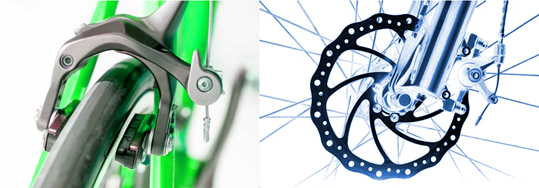 Brakes?
Brakes?
When considering buying a road bike, the choice of brake type is an important consideration. There are two primary types of brakes commonly used on road bikes:
Rim Brakes (Caliper Brakes)
Rim brakes use friction between brake pads and the rim of the wheel to slow down and stop the bike. They are lightweight, simple in design, and have been the traditional choice for road bikes for many years. Rim brakes are available in different variations, including single-pivot caliper brakes and dual-pivot caliper brakes. They provide reliable stopping power and are typically easier to maintain and service. However, their braking performance can be affected by wet conditions, and the rims can wear over time.
Disc Brakes
Disc brakes use a rotor attached to the hub of the wheel and calipers to apply braking force. They offer several advantages over rim brakes. Disc brakes provide more consistent and powerful braking performance, particularly in wet or adverse weather conditions. They are less affected by rim wear and can accommodate wider tires. Disc brakes also offer more modulation, meaning the braking force can be finely controlled, allowing for better control and confidence when descending or maneuvering. However, they tend to be slightly heavier and may require more maintenance, including rotor alignment and occasional pad replacement.
When choosing between rim brakes and disc brakes, consider the following factors:
Riding Conditions
If you frequently ride in wet or hilly areas, or if you participate in long descents, disc brakes may provide more consistent and reliable braking performance, giving you increased confidence and safety. Rim brakes can still offer sufficient stopping power in dry conditions and are suitable for riders who prioritize weight savings.
Tire Clearance
Disc brakes offer more tire clearance, allowing for the use of wider tires. This can enhance comfort, traction, and overall versatility, particularly if you plan to ride on rougher roads, gravel, or unpaved surfaces.
Wheel and Frame Compatibility
Disc brakes require specific hubs and frame/fork designs with mounts for disc calipers. Ensure that the road bike you choose is compatible with your preferred brake type.
Personal Preference
Some riders simply prefer the feel and modulation of one brake type over the other. If you have the opportunity, test ride bikes equipped with both rim brakes and disc brakes to determine which type suits your riding style and preferences. It’s worth noting that the industry trend is shifting towards disc brakes, and many new road bike models now come with disc brake options. However, rim brakes are still widely available and may be a suitable choice depending on your riding needs and preferences.
Ultimately, the choice of brake type should be based on your specific riding conditions, preferences, and the type of performance you desire. Consulting with experienced riders, seeking advice from bike shop professionals, and test riding different bikes can help you make an informed decision.
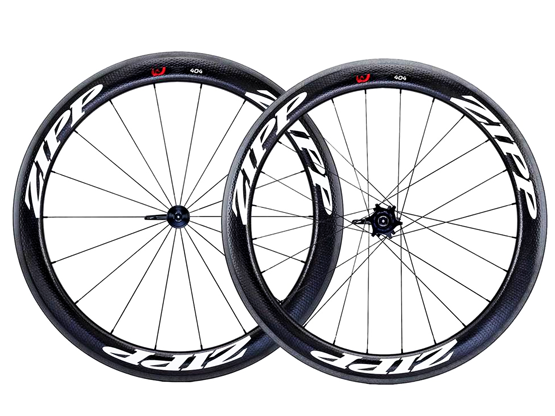 Which Style of Wheels?
Which Style of Wheels?
When considering the wheels for a road bike, there are several important factors to take into account:
Rim Material
Road bike wheels commonly come with rims made of aluminum or carbon fiber.
Aluminum rims are durable, affordable, and provide good braking performance.
Carbon fiber rims are lighter, stiffer, and offer improved aerodynamics, but they can be more expensive.
Rim Depth
Rim depth refers to the height of the rim.
Deeper rims, typically between 40-60mm, are more aerodynamic and can provide a speed advantage, especially in flat or rolling terrain.
However, they can be more affected by crosswinds.
Shallower rims (around 30mm or less) are lighter and more nimble, making them ideal for climbing and windy conditions.
Rim Width
The width of the rim affects tire compatibility and ride quality.
Wider rims (typically 17-21mm internal width) allow for the use of wider tires, which can enhance comfort, traction, and cornering performance.
They also improve aerodynamics when paired with wider tires by creating a smoother airflow transition.
Spokes
The number and type of spokes in the wheel can affect durability, weight, and aerodynamics.
Traditional wheels often have 32 or 36 spokes, providing robustness but adding weight.
Some modern wheels have fewer spokes (e.g., 24 or even 16) for reduced weight and improved aerodynamics, but they may sacrifice some durability.
Additionally, consider whether the spokes are bladed (aerodynamic) or round (stronger).
Hub Quality
The hub houses the bearings and affects the wheel’s smoothness, durability, and ease of maintenance.
Look for high-quality hubs with sealed bearings for reduced friction and better longevity.
Well-known hub manufacturers include Shimano, DT Swiss, and Chris King.
Weight
Lighter wheels can enhance acceleration and climbing performance.
However, lighter wheels may sacrifice some durability and stability, particularly for heavier riders or rougher road conditions.
It’s important to strike a balance between weight and durability based on your riding style and terrain.
Tubeless Compatibility
Tubeless wheels allow you to run tires without inner tubes, offering benefits such as lower rolling resistance, increased puncture resistance, and the ability to run lower tire pressures for improved comfort.
Consider whether the wheels are designed to be tubeless-ready or if they require additional conversion kits.
Brand and Reputation
Opt for reputable wheel brands known for their quality and reliability.
Brands like Shimano, DT Swiss, Zipp, Mavic, Enve, Fulcrum, and Reynolds have a solid reputation and offer a range of options to suit different needs and budgets.
Ultimately, the choice of road bike wheels depends on your riding goals, terrain, budget, and personal preferences.
It can be helpful to test ride different wheelsets or seek advice from experienced cyclists or bike shop professionals to find the best match for your specific requirements.
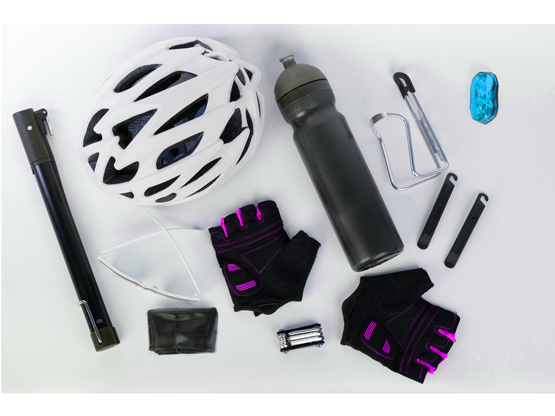 What Accessories Do I Need When Buying a Road Bike?
What Accessories Do I Need When Buying a Road Bike?
When buying a road bike, it’s important to consider the accessories that can enhance your riding experience, safety, and convenience.
Here are some common accessories to consider:
Helmet
A helmet is a crucial safety accessory that protects your head in case of a fall or collision.
Look for a properly fitting helmet that meets safety standards and provides good ventilation for comfort.
Cycling Clothing
Cycling-specific clothing can provide comfort, moisture-wicking properties, and aerodynamic benefits.
Consider investing in padded cycling shorts, jerseys, gloves, and socks designed for road cycling.
Bike Lock
If you plan to leave your bike unattended in public areas, a reliable bike lock is essential for preventing theft.
Choose a sturdy lock that suits your security needs and consider a secondary lock for added protection.
Lights
Front and rear lights are essential for visibility, especially if you ride during low-light conditions or at night.
Ensure your lights are bright, have different modes (steady and flashing), and are easily removable for charging.
Water Bottle Cage
Staying hydrated is important during rides.
A water bottle cage attached to the bike frame allows you to conveniently carry a water bottle for easy access while riding.
Bike Pump
A portable bike pump is useful for maintaining proper tire pressure while on the go.
Look for a compact and lightweight pump that is compatible with your valve type (presta or Schrader).
Bike Computer or GPS
A bike computer or GPS device can provide valuable ride data such as speed, distance, time, and navigation.
Consider your data needs and budget when choosing a device.
Saddle Bag or Bikepacking Bags
These bags attach to the bike frame or saddle and provide storage space for essential items like a spare tube, multi-tool, tire levers, and patch kit.
Fenders
Fenders or mudguards are beneficial for riding in wet conditions as they help keep water and mud off you and the bike, keeping you cleaner and drier.
Car Bike Rack
If you plan to transport your road bike by car, a bike rack that securely attaches to your vehicle can be convenient and ensure safe transportation.
These are just a few examples of accessories to consider.
Depending on your needs and preferences, there may be additional accessories like bike racks, smartphone mounts, cycling shoes, pedals, or a bike computer that can enhance your road cycling experience.
When purchasing accessories, ensure compatibility with your bike and consider quality, durability, and value for money.
Researching product reviews, seeking recommendations, and consulting with experienced riders or bike shop professionals can help you choose the right accessories for your road bike.
 How Much Do I Need To Spend When Buying a Road Bike?
How Much Do I Need To Spend When Buying a Road Bike?
When it comes to the price of road bike wheels, there is a wide range depending on the materials, construction, brand, and performance level.
Here’s a general breakdown of price categories:
Entry-Level
Entry-level road bike wheels are typically made of aluminum rims and have basic hub designs.
These wheels are suitable for beginners or riders on a budget. Prices can range from around $100 to $300 for a wheelset.
Mid-Range
Mid-range road bike wheels offer a balance between weight, performance, and durability.
They may feature aluminum or carbon rims with improved aerodynamics and higher-quality hub components.
Prices for mid-range wheelsets can vary from $300 to $800.
High-End/Performance
High-end road bike wheels are designed for competitive riders and enthusiasts seeking the best performance.
They often feature carbon fiber rims for lightweight and aerodynamic advantages, advanced hub designs with high-quality bearings, and other technologies for enhanced performance.
Prices for high-end wheelsets typically start around $800 and can go well into the thousands of dollars.
**It’s important to note that these price ranges are approximate, and specific models from different manufacturers may have variations in pricing. Additionally, individual components, such as aero or lightweight carbon rims, can significantly affect the cost.
When considering the price, it’s essential to align your budget with your riding goals, frequency, and expectations. It’s also worth considering that upgrading the wheels on a road bike can have a noticeable impact on performance, so investing in a higher-quality wheelset can be a worthwhile long-term investment.
Lastly, it’s recommended to research different brands, read reviews, and consult with experienced cyclists or professionals at bike shops to find the best balance between price and performance for your specific needs.
What Are the Reputable Road Bike Brands?
There are several reputable road bike brands known for their quality, innovation, and performance in the cycling industry.
Here are some well-regarded road bike brands:
Specialized
Specialized is a widely recognized brand that offers a diverse range of road bikes. They are known for their attention to detail, cutting-edge technology, and rider-focused designs. Specialized offers road bikes for various disciplines, including racing, endurance, and gravel.
Trek is a popular brand that produces a wide range of road bikes, from entry-level to high-performance models. They are known for their extensive research and development, incorporating advanced features and materials into their road bike lineup. Trek offers road bikes suitable for recreational riders, enthusiasts, and professional racers.
Giant is one of the world’s largest bicycle manufacturers and is highly regarded for their road bikes. They offer a comprehensive range of road bike models, including lightweight climbing bikes, aerodynamic race bikes, and endurance-focused options. Giant emphasizes performance, innovation, and value across their product line.
Canyon
Canyon is a German brand known for its direct-to-consumer model, offering high-quality road bikes at competitive prices. They are recognized for their engineering expertise, aerodynamic designs, and lightweight frames. Canyon road bikes have gained popularity among amateur and professional riders alike.
Pinarello
Pinarello is an Italian brand with a rich history in the road cycling world. They are renowned for their race-winning road bikes, favored by professional teams and riders. Pinarello bikes are known for their elegant designs, cutting-edge technology, and meticulous craftsmanship.
Cervélo
Cervélo is a brand dedicated to engineering fast and aerodynamic road bikes. They have a strong presence in the competitive cycling scene and are known for their wind tunnel testing and attention to aerodynamic details. Cervélo road bikes are favored by triathletes, time trialists, and riders seeking speed and efficiency.
Colnago
Colnago is an iconic Italian brand that has been producing road bikes for over six decades. They are known for their classic designs, exceptional craftsmanship, and high-performance road bikes. Colnago is often associated with the heritage and passion of Italian cycling.
Scott
Scott is a brand that offers a wide range of road bikes suitable for different riding styles and disciplines. They are known for their innovative technologies, including carbon fiber frame construction and aerodynamic designs. Scott road bikes cater to both competitive and recreational riders.
BMC
BMC is a Swiss brand known for their high-quality road bikes. They combine sleek designs with cutting-edge technology and are favored by both professional teams and enthusiasts. BMC offers road bikes for various disciplines, including racing, endurance, and gravel.
Orbea
Orbea is a Spanish brand that has gained recognition for their road bikes’ performance, quality, and aesthetics. They offer a range of road bike models suited for different riding styles and preferences. Orbea is known for their attention to detail and customizable options.
Ridley
Ridley is a Belgian brand that has established itself as a leader in the road cycling world. They specialize in producing race-oriented road bikes that excel in performance and aerodynamics. Ridley road bikes have been ridden to victories in prestigious races, earning them a reputation for speed and responsiveness.
Bianchi
Bianchi is an iconic Italian brand with a long history in road cycling. They are known for their distinctive celeste-colored frames and classic designs. Bianchi road bikes blend tradition with modern technology, offering a range of models for various riding disciplines and styles.
Wilier Triestina
Wilier Triestina is an Italian brand with a strong heritage in road cycling. They are known for their attention to detail, craftsmanship, and performance-oriented road bikes. Wilier Triestina offers road bikes for racing, endurance, and gravel riding, combining Italian style with technological advancements.
Merida
Merida is a Taiwanese brand that has gained recognition for their road bikes’ quality and value. They produce a wide range of road bikes catering to different riding styles and budgets. Merida emphasizes performance, reliability, and innovation across their product line.
Focus
Focus is a German brand that offers a diverse lineup of road bikes suitable for various disciplines. They are known for their precision engineering, quality construction, and attention to detail. Focus road bikes are designed to deliver performance and reliability.
These are just a few notable road bike brands, and there are many other reputable brands in the market.
It’s important to consider your specific needs, budget, and preferences when choosing a road bike brand.
Researching reviews, consulting with experienced riders, and test riding different models can help you find the brand that best aligns with your requirements.

